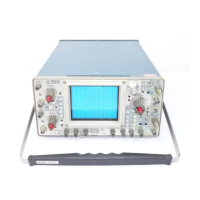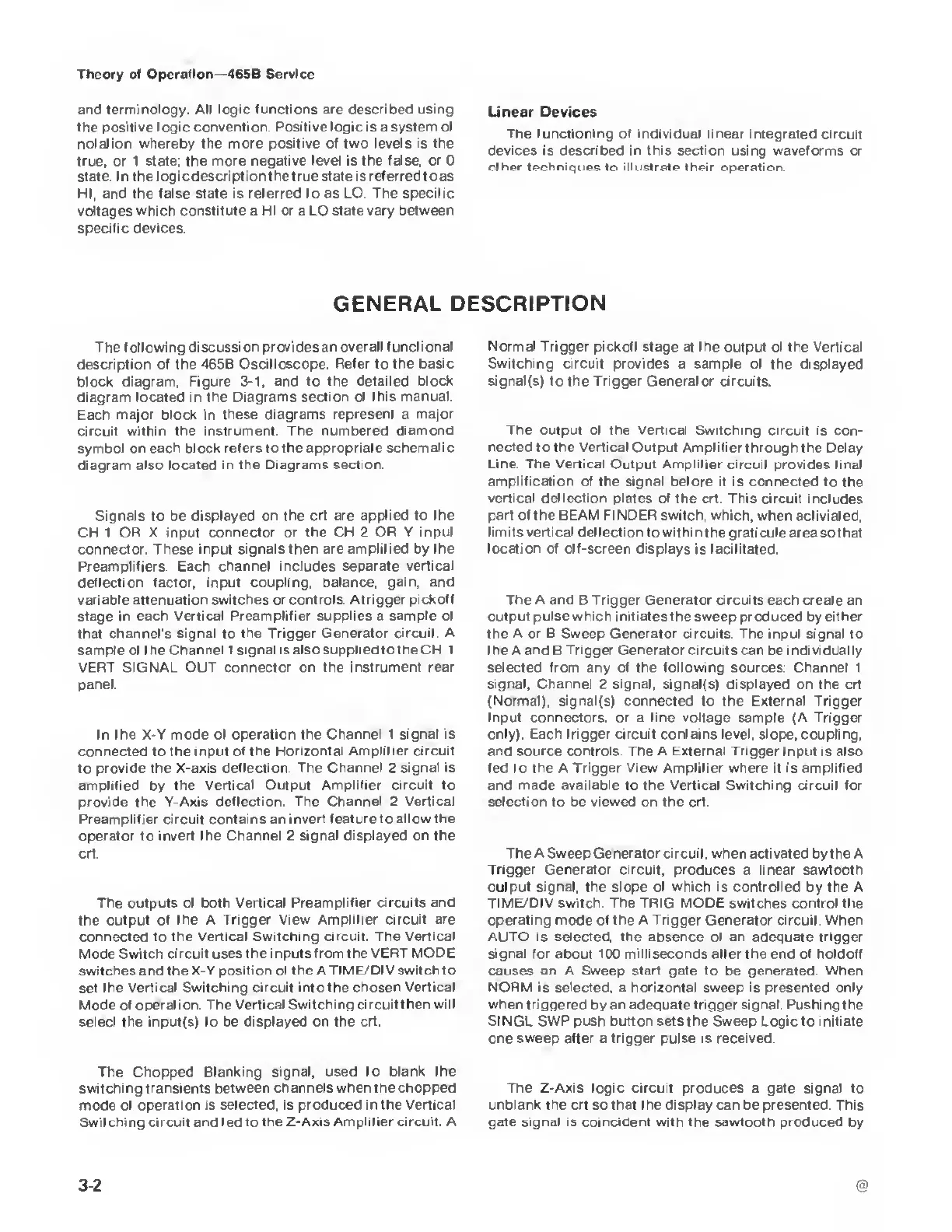Theory
of Operation—465B Service
and
terminology. All logic
functions are
described
using
the
positive logic convention. Positive logic is a system of
notation
whereby
the more positive of two levels is the
true, or 1 state; the
more negative level is the false, or 0
state. In the
logic description the true state is referred to as
HI, and the false state is
referred to as LO. The specific
voltages which constitute a HI or a LO state
vary between
specific devices.
Linear Devices
The functioning of individual linear
integrated circuit
devices is described in this section using waveforms
or
other techniques to illustrate their operation.
GENERAL
DESCRIPTION
The
following discussion provides an
overall functional
description of the 465B Oscilloscope.
Refer
to
the basic
block
diagram, Figure 3-1, and to the
detailed block
diagram
located in the Diagrams section of this
manual.
Each major block in these
diagrams
represent
a major
circuit within the
instrument The numbered diamond
symbol on each block refers to
the appropriate schematic
diagram also located in the
Diagrams section.
Signals to
be
displayed on
the crt
are
applied to the
CH 1 OR X input connector or
the CH
2
OR Y input
connector. These input
signals
then are
amplified
by
the
Preamplifiers. Each channel
includes separate vertical
deflection factor,
input coupling, balance, gain, and
variable attenuation
switches
or
controls. Atrigger pickoff
stage in each Vertical
Preamplifier supplies a sample of
that channel's signal to the
Trigger Generator circuit. A
sample of the Channel 1 signal is also
supplied tot he CH l
VERT SIGNAL OUT connector on the instrument rear
panel.
In the
X-Y
mode
of operation the
Channel
1
signal is
connected
to
the input of the
Horizontal Amplifier
circuit
to provide the
X-axis deflection.
The Channel
2
signal is
amplified
by
the Vertical Output
Amplifier circuit
to
provide
the Y-Axis deflection. The Channel 2
Vertical
Preamplifier circuit
contains an invert featureto allowthe
operator to invert the
Channel 2 signal displayed on the
crt.
The outputs
of both Vertical Preamplifier circuits and
the output of the A
Trigger View Amplifier circuit are
connected to
the Vertical Switching circuit. The Vertical
Mode Switch circuit uses
the
inputs
from the VERT MODE
switches and the X-Y
position
of the A
TIME/DI
V switch to
set the
Vertical Switching circuit into the
chosen Vertical
Mode of operation. The Vertical
Switching circuit then will
select the
input(s)
to
be displayed on the crt.
The Chopped Blanking signal, used to
blank the
switching transients between
channels
when the
chopped
mode of operation is selected,
is produced in the Vertical
Switching circuit and fed to the
Z-Axis Amplifier circuit A
Normal Trigger pickoff stage at
the output of the Vertical
Switching
circuit
provides a sample
of the displayed
signal(s) to
the
Trigger
Generator circuits.
The output of the vertical
Switching circuit is con-
nected
to
the Vertical
Output Amplifier through the Delay
Line.
The Vertical Output Amplifier circuit provides final
amplification of the signal before it is
connected to the
vertical
deflection
plates of the crt.
This circuit includes
part of the BEAM FINDER switch, which,
when activiated,
limits vertical deflection
to
within
the graticule area
sothat
location of off-screen displays
is
facilitated.
The A and B Trigger Generator circuits each create an
output pulse which initiates the sweep produced by either
the A or B Sweep Generator circuits. The input signal
to
the A and B Trigger Generator circuits can
be
individually
selected from any of the following sources: Channel
1
signal, Channel 2 signal, signal(s) displayed on the crt
(Normal), signal(s) connected to the External Trigger
Input
connectors, or a line voltage sample (A Trigger
only)
Each
trigger circuit contains
level,
slope, coupling,
and source controls The A External
Trigger
input is also
fed to the A
Trigger
View Amplifier where it is amplified
and made available to the Vertical Switching circuit
for
selection to
be
viewed on the
crt.
The A Sweep Generator circuit, when activated
by
the A
Trigger Generator circuit, produces a linear sawtooth
output signal, the slope of which is controlled
by
the A
TIME/DIV switch. The TRIG MODE switches control the
operating mode of the A Trigger Generator circuit. When
AUTO is selected, the absence
of
an adequate trigger
signal for about 100 milliseconds after the end of holdoff
causes an A Sweep
start
gate to be generated When
NORM
is selected, a
horizontal
sweep is presented only
when triggered
by
an adequate
trigger
signal Pushing
the
SINGL SWP
push
button
sets the Sweep Logic to initiate
one sweep
after a
trigger
pulse is received
The Z-Axis logic circuit produces a gate signal to
unblank the crt
so
that
the
display
can be
presented.
This
gate signal
is
coincident with the sawtooth produced by

